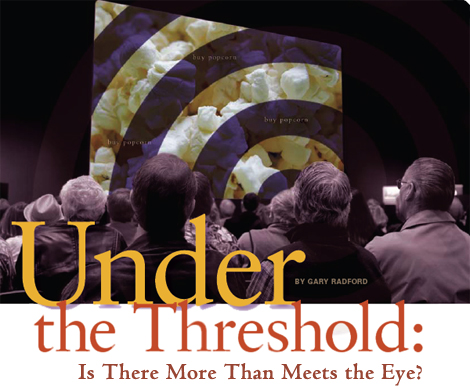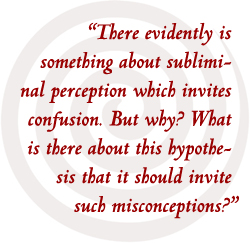



On September 12, 1957, a market researcher held a press conference in New York City that would capture and excite the imagination of millions. The researcher’s name was James Vicary, and on this day he unveiled to the world a new subliminal projection technology that would revolutionize advertising by promoting products directly to the needs and desires of the unconscious mind. Vicary claimed to have demonstrated that subliminal messages flashed on a movie screen could induce audiences to buy more popcorn and Coca-Cola at the intermission. Since that time, the popular notion of subliminal persuasion has remained and become increasingly mythologized with the passing of the years.
The reporting of Vicary’s press conference, and not the claims of experimental psychologists, has come to define the popular notion of subliminal persuasion. For example, The Wall Street Journal reported Vicary’s presentation as follows:
“This story may sound as though a flying saucer is lurking somewhere behind the scenes, but you can rest assured all characters in this drama are real. The tale begins some months ago when several closemouthed men walked into a New Jersey motion picture house and fitted a strange mechanism to the film projector. Over the next six weeks, as 45,699 unsuspecting moviegoers watched Hollywood’s newest epics, a strange thing reportedly occurred.
Out of the blue, it is claimed, patrons started deserting their seats and crowding in the lobby. Sales of Coca-Cola reportedly rose 18.1 percent and popcorn purchases zoomed 57.7 percent over the theater’s usual sales. These claims — and the explanation of this purported phenomenon — were made at a press conference yesterday afternoon by executives of a new firm called Subliminal Projection Co., Inc. The movie patrons had been subjected to ‘invisible advertising’ that bypassed their conscious and assertedly struck deep into their subconscious. The trick was accomplished by flashing commercials past the viewers’ eyes so rapidly that viewers were unaware they had seen them. The ads, which were flashed every five seconds or so, simply urged the audience to eat popcorn and drink Coca-Cola, and they were projected during the theater’s regular movie program.”
Nearly four decades later, the intriguing concept of subliminal perception remains vibrant in U.S. popular culture, and surveys consistently report that the general public is aware of the term and believes the “technique” to be in use by advertisers and the mass media. The term invokes the image of mass “covert control” carried out by an elite group of business people and politicians through the use of messages that people cannot see or hear. For the majority of Americans, the term “subliminal perception” invokes reactions that are negative and perhaps even a little bit frightening: things like brainwashing, mind-control or maybe ESP. But how did we derive these reactions, and why do we talk about subliminal perception the way we do?
Popular Images
Subliminal messages bypass conscious recognition and evaluation and communicate directly to the unconscious level of drives, emotions and desires. Many believe that subliminal techniques are in widespread use by media, advertising and public relations agencies, industrial and commercial corporations and by the federal government. Concerns about the nature of subliminal persuasion have been the subject of a United Nations resolution and a congressional hearing.
Reports of subliminal persuasion in the news media reinforce the notion of covert control. In the late 1970s and early 1980s, it was reported that a device known as the “black box,” itself a name implying mysterious power, could mingle the bland music found in department stores with subliminal antitheft messages such as “I am honest” and “I will not steal.” The hit movie “The Exorcist” was reported to have included subliminal images of a death mask, which some claim significantly contributed to extreme feelings of terror and sickness. Perhaps the most well-known news event involving subliminal persuasion was the case of two teenagers who, in 1985, attempted to commit suicide after listening to the Judas Priest album “Stained Class.” The case against Judas Priest and CBS Records built upon a still popular belief that subliminal messages are embedded in rock music for questionable ends.
More recently, the power of subliminal persuasion has been successfully packaged as a product in the form of subliminal self-help tapes. The producers of these tapes claim, among other things, that subliminal messages have the capacity to relieve stress, increase sex appeal, facilitate weight loss, stop cigarette smoking and improve one’s golf game.
Popular media representations typically reinforce and exaggerate the “power” of subliminal persuasion techniques to control an individual’s thoughts and behavior. For example, in the television series based on H.G. Wells’ The War of the Worlds, aliens implant subliminal messages into a rock album with the intent of brainwashing and controlling the protagonist. In John Carpenter’s movie “They Live,” aliens control the human population of Earth with subliminal messages. In an episode of “The Simpsons,” Homer accidentally receives a subliminal self-help tape that increases vocabulary instead of inducing weight loss and begins talking like Shakespeare.
Perception and Reality
The idea of “the subliminal” is mysterious in its very definition. For example, the Oxford English Dictionary defines a subliminal stimulus as one that is presented “below the threshold of sensation or consciousness.”
A large body of experimental literature dating back to the late 19th century strongly suggests that humans have the ability to “perceive” subliminal stimuli. This phenomenon, known as subliminal perception, is defined by Norman Dixon, the pre-eminent researcher on this topic, as “a class of phenomena which have in common the fact that the subject professes unawareness of stimuli which are affecting his/her behavior.” In experimental psychology, these behavioral effects are typically small and highly controlled.
Subliminal communication is a broader term that refers to the perception of more complex subliminal messages, such as sentences and images, as indicated by a specific behavioral response to that message. Subliminal persuasion posits the existence of a relationship between exposure to subliminal messages, usually through mass media such as television or film, and larger scale and more complex changes in a person’s beliefs, emotions and behavior.
Although the evidence for the limited effects attributed to subliminal perception is reliable and consistent, Dixon, in his extensive review of the subliminal literature, concludes that he has not seen a “shred of valid published evidence” to substantiate the claims that subliminal perception can be used for brainwashing or mind control and that “nobody, except perhaps those interested in the commercial exploitation of subliminal stimulation, would maintain that a subliminal stimulus can compete successfully with other more powerful influences.”

The most clearly documented effects of subliminal stimuli are obtained only in highly contrived and artificial situations. These effects, when present, are brief and of small magnitude. So how can dramatic terms and phrases such as “mind control,” “persuasion” and “subliminal seduction” so easily free-associate in the speech of ordinary people? Dixon writes in exasperation: “There evidently is something about subliminal perception which invites confusion. But why? What is there about this hypothesis that it should invite such misconceptions?”
FDU Magazine Home | Table of Contents | FDU Home | Alumni Home | Comments
©Copyright 2007 Fairleigh Dickinson University. All rights reserved.
For a print copy of FDU Magazine, featuring this and other stories, contact Rebecca Maxon, editor, 201-692-7024 or maxon@fdu.edu.